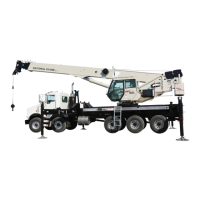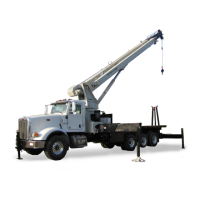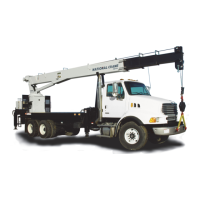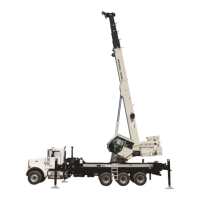National Crane 3-29-2018 Control # 610-00 2-37
NBT40-1 SERIES OPERATOR MANUAL SAFETY INFORMATION
If applicable to your equipment, frequently check all air tanks
for water in freezing weather.
Never store flammable materials on the equipment.
National Crane recommends use of cold weather starting
aids that are provided on your equipment, use them. The use
of aerosol spray or other types of starting fluids is prohibited.
TEMPERATURE EFFECTS ON HOOK
BLOCKS
The following information applies to all crane hook blocks:
“ Never use a crane block in extreme
temperatures...Sudden failure can occur.
Crane blocks shall not be heated above 82°C (180°F).
Craneblock Working Load Limit is valid between 82°C
(180°F) and service temperature given on the identification
tag with normal lifting precautions.
Additional lifting precautions are required below the service
temperature given on the identification tag because cold
temperature begins to affect the equipment block material
properties.
Lifting above 75% of the Working Load Limit (WLL), at
temperatures between the service temperature given on the
identification tag and -40°C (-40°F), must (be) done at a slow
and steady rate to avoid stress spikes common in normal
hoisting dynamics.
75% of the WLL must not be exceeded, when lifting in
temperatures below -40°C (-40°F).”
TEMPERATURE EFFECTS ON HYDRAULIC
CYLINDERS
Hydraulic oil expands when heated and contracts when
cooled. This is a natural phenomena that happens to all
liquids. The coefficient of expansion for API Group 1
hydraulic oil is approximately 0.00077 cubic centimeters per
cubic centimeter of volume for 1°C of temperature change
(0.00043 cubic inches per cubic inch of volume for 1°F of
temperature change). Thermal contraction will allow a
cylinder to retract as the hydraulic fluid which is trapped
in the cylinder cools.
The change in the length of a cylinder is proportional to the
extended length of the cylinder and to the change in
temperature of the oil in the cylinder. For example, a cylinder
extended 7.6 m (25 ft) in which the oil cools 15.5°C (60°F)
would retract approximately 196 mm (7 3/4 in) [see Table 2-
8]. A cylinder extended 1.5 m (5 ft) in which the oil cools
15.5°C (60°F) would only retract approximately 38 mm (1 1/
2 in). The rate at which the oil cools depends on many
factors and will be more noticeable with a larger difference in
oil temperature verses the ambient temperature.
Thermal contraction coupled with improper lubrication or
improper wear pad adjustments may, under certain
conditions, cause a “stick-slip” condition in the boom. This
“stick-slip” condition could result in the load not moving
smoothly. Proper boom lubrication and wear pad adjustment
is important to permit the boom sections to slide freely. Slow
movement of the boom may be undetected by the operator
unless a load is suspended for a long period of time. To
minimize the effects of thermal contraction or “Stick-slip” it is
recommended that the telescope control lever is activated
periodically in the extend position to mitigate the effects of
cooling oil.
If a load and the boom is allowed to remain stationary for a
period of time and the ambient temperature is cooler than the
trapped oil temperature, the trapped oil in the cylinders will
cool. The load will lower as the telescope cylinder(s) retracts
allowing the boom to come in. Also, the boom angle will
decrease as the lift cylinder(s) retracts causing an increase
in radius and a decrease in load height.
This situation will also occur in reverse. If equipment is set up
in the morning with cool oil and the daytime ambient
temperature heats the oil, the cylinders will extend in similar
proportions.
Table 2-8 and Table 2-9 have been prepared to assist you in
determining the approximate amount of retraction/extension
that may be expected from a hydraulic cylinder as a result of
change in the temperature of the hydraulic oil inside the
cylinder. The chart is for dry rod cylinders. If the cylinder rod
is filled with hydraulic oil, the contraction rate is somewhat
greater.
NOTE: Operators and service personnel must be aware
that load movement, as a result of this phenomena,
can be easily mistaken as leaking cylinder seals or
faulty holding valves.

